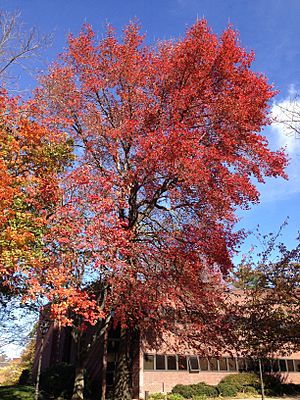Tupelo facts for kids
Quick facts for kids Tupelo |
|
|---|---|
 |
|
| Nyssa sylvatica leaves and flowers | |
| Scientific classification |
|
| Kingdom: | Plantae |
| Clade: | Tracheophytes |
| Clade: | Angiosperms |
| Clade: | Eudicots |
| Clade: | Asterids |
| Order: | Cornales |
| Family: | Nyssaceae |
| Genus: | Nyssa Gronov. ex L. |
| Synonyms | |
|
|
Tupelo trees, also known by their scientific name Nyssa, are a small group of trees that lose their leaves every year. Their leaves are simple and grow in an alternating pattern along the branch. Scientists sometimes place tupelo trees in the dogwood family, called Cornaceae. Other experts put them in their own family, Nyssaceae. The APG IV system, a modern way to classify plants, places them in the Nyssaceae family.
Most tupelo species can handle very wet soils and even floods. Some of them actually need these watery places to grow well. You can find some species growing naturally in eastern North America. This area stretches from southeastern Canada, through the eastern United States, and down to Mexico and Central America. Other types of tupelo trees grow in eastern and southeastern Asia. This includes places like China, Indochina, Java, and the Himalayas.
Contents
What's in a Name?
The scientific name Nyssa comes from an ancient Greek word. It refers to a naiad, which was a water nymph or spirit in Greek stories. This name makes sense because many tupelo trees love to grow in wet, watery places.
The common name tupelo comes from Native American languages. It comes from the Creek language words ito, meaning 'tree', and opilwa, meaning 'swamp'. People have been using this name since the mid-1700s. It's important not to confuse the tupelo tree with the tulip poplar tree, which is a different kind of tree.
The city of Tupelo, Mississippi, in the United States, was named after this special tree.
Types of Tupelo Trees
There are about seven to ten different kinds of living tupelo trees. Here are some of the well-known ones:
- Nyssa aquatica – This is called the Water tupelo. It grows in the southeastern United States.
- Nyssa biflora – Also known as Swamp tupelo or swamp black-gum.
- Nyssa javanica – Found in the Eastern Himalayas, Indochina, Borneo, Java, and Sumatra.
- Nyssa ogeche – This is the Ogeechee tupelo. It grows in the southeastern United States.
- Nyssa sinensis – Known as Chinese tupelo. It grows in southern China, Vietnam, and Myanmar.
- Nyssa sylvatica – Called Black tupelo or black-gum. It grows across the eastern and central United States, eastern and southern Mexico, and Ontario in Canada.
- Nyssa talamancana – Found in Panama and Costa Rica.
- Nyssa yunnanensis – Known as Yunnan tupelo. It grows in Yunnan, China.
How People Use Tupelo Trees
Tupelo wood is very popular with artists who carve wood. They especially like to carve ducks and other wild birds from it. The wood is easy to carve with power tools and can hold tiny details, even at the ends of the wood grain.
In business, tupelo wood is used for making shipping boxes and the inside parts of furniture. It is also used a lot in the veneer and panel industry. This means it's used for layers in plywood and for the backs of panels. The wood can also be easily turned into wood pulp, which is used to make high-quality paper for books and magazines. In the past, people even used hollow tupelo tree trunks as "bee gums" to hold beehives.
Tupelo trees are also popular as ornamental trees in gardens and parks. People love them for their beautiful shape when they are fully grown, the shade they provide, and their amazing autumn leaf colors. Their leaves turn bright shades of red and scarlet in the fall.
The Ogeechee Tupelo, sometimes called the Ocheechee Lime, grows naturally in Georgia and northern Florida. This tree produces an edible fruit. It's a sour, oval-shaped fruit called a drupe.
Tupelo Honey
Tupelo trees, especially the Nyssa ogeche species, are very important for making honey in the southeastern United States. This is especially true in the Gulf Coast area. These trees produce a very light-colored honey with a mild taste.
In Florida, beekeepers place their beehives along river swamps. They often put them on platforms or floats during the time when tupelo trees bloom. This helps them produce pure tupelo honey. This honey sells for a high price because of its unique flavor. Honey made only from the nectar of Nyssa ogeche flowers has a lot of fructose and not much glucose. This special balance means it does not crystallize, or turn solid, over time.
The Apalachicola River in the Florida Panhandle is a famous place for tupelo honey production. While tupelo honey is made wherever the three species of tupelo trees bloom in the southeastern USA, the purest and most expensive kind comes from this valley. Experts can check the honey's purity by looking at its pollen under a microscope. In a good year, the tupelo honey crop made by a few special Florida beekeepers can be worth almost $1,000,000.
Ancient Tupelo Trees
Scientists have found fossilized fruits that look just like modern Nyssa fruits. These fossils were found in Alberta, Canada, and date back to the Campanian age. This shows that trees similar to today's tupelo trees have been around for a very long time. These ancient fruits are similar to a type commonly found from the Paleogene period, which used to be called Palaeonyssa.
See also
 In Spanish: Nyssa para niños
In Spanish: Nyssa para niños



